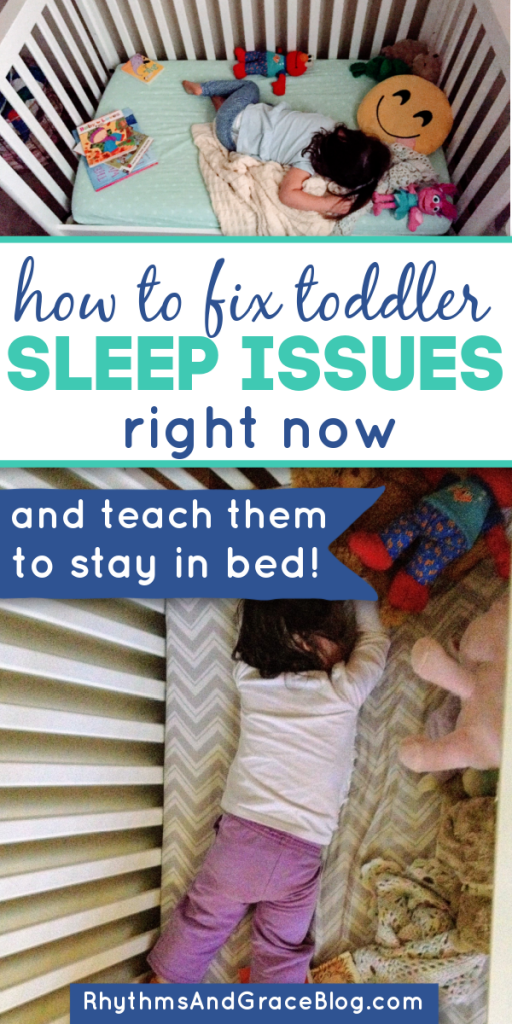Some of the links on this page are affiliate links. When you make a purchase through an affiliate link, I earn a commission at no cost to you. See my entire disclosure policy for all the boring details.
In this post, you will learn everything you need to know about creating a healthy sleep plan for your 2 year old. From creating a consistent nap time to healthy nightly routines to problems that could interrupt your toddler’s sleep, we’re going to walk through all the basics that will be helpful as you set out to help your toddler’s sleep habits. (After all, a toddler with healthy sleep habits makes for much more sane parents!)
As a mother of 4 children, I’ve been through it all regarding naps and bedtime. And I wasn’t born with this knowledge… none of us moms are! But I sought out help from other moms, my pediatrician, and a handful of books. Oh, and there was the desperate internet searching at 3:00 in the morning.
Our kids have all been different levels of “naturally good sleepers,” but, after a few toddlers, we’ve learned a handful of guidelines for establishing good toddler sleep habits & routines.
Implementing these routines and tips will make a positive difference in your child’s sleep experience (and will give you a much-needed rest as well)!
I also included some sample schedules to give you some guidance on how to plan your days.
It’s time for everyone to get a good night’s sleep – let’s get started!
Good 2 Year Old Sleep Habits
How much sleep does a 2-year-old need?
The American Academy of Pediatrics recommends between 11 and 14 hours of sleep each day including naps. If this seems like a lot to you, consider how fast your child is growing at this age. All that development is tiring! If you’ve ever been around a 2-year old that hasn’t napped, you know what I mean. An overtired toddler is unpleasant to say the least.
What time should a 2 year old go to bed?
Your 2 year old’s bedtime will depend on your family’s sleep schedule to some degree. But, most children sleep their deepest between 8:30 pm and midnight, so keep that in mind when planning out bedtime for 2 year olds. Try to get them in bed by 7:30 or 8:00 most nights, so that the 2 year old sleep schedule allows for deep sleep by 8:30 pm or so.
Bedtime will also depend on their nap schedule. Most 2-year-olds will still be napping at least once during the day, and a reasonable bedtime will be about 4-5 hours after they wake up from their nap. So, if your child naps from 1 to 3 pm, then they could go to bed around 8 pm, and should wake up around 7 or 8 am.
Each child will be different, but as long as you’re hitting that 11 to 14-hour range, your toddler should be fine. The best way to tell if your child is getting enough sleep is to watch their behavior. If they seem particularly cranky, are rubbing their eyes, laying down on the floor to rest while playing, or are more emotional than usual, these are all good signs that they may not be getting enough sleep.

2 Year Old Nap Tips
Do Toddlers Need a Nap?
Nap time is still very important to a 2 year old’s development. It’s also critical to a parent’s sanity! This break in the day gives everyone a chance to recharge. Usually, by this age, a child will be taking one long nap each day (rather than a morning nap and an afternoon nap). This time, combined with their overnight sleeping hours, makes up the recommended 11 to 14 hours of sleep in 24 hours.
What Time Should Toddlers Nap? (Cues vs. Clock)
A 2-year-old’s nap time will vary depending on your schedule and the time they usually wake up in the morning and go to bed at night. Generally, a toddler at this age has a wake time of about 5 hours. So, if your child gets up in the morning around 8:00 am, they should be ready for their nap around 1:00 pm.
How Long Should a Two Year Old Nap?
We usually let our kids sleep as long as they want in the afternoons, but if they start having trouble going to sleep later at night, we make sure to have them nap on the early side and not sleep any later than 2:30 or 3.
Try to pay attention for when your toddler seems tired rather than being rigid about a specific nap time. For example, if you’ve had a particularly busy couple of days, your two year old might be cranky by 11:30 am… early nap time today!
Another day, you might want to head to the park for a picnic at 11:30 and your child will start nap time around 1:30 or 2. That’s okay! Nap times can be flexible while still being consistent.
Unless we’re out and about, our kids know that we read a story during lunch and rest time happens afterwards! For our toddler, the routine is a trip to the potty, darkening the room, turning on a white noise machine, and reading a story in his rocking chair. Then I sing him a song as he snuggles his blankets, and close the door on my way out.
Whenever nap time turns out to be, if you are consistent with these clues, they will wind down quickly and will go to sleep.
The Toddler-Turned-Monster
Young children thrive on routine, though some are more flexible than others. We had one child who was particularly inflexible when it came to sleep. If I wasn’t home for a nap before 1:00 pm, it was anarchy.
Sometimes we just had to be out, and when we got home, he was melting down. But often, I just respected that his body needed the sleep, and our whole afternoon was more peaceful if he could be sleeping before 1:00. It was just a season, and he grew out of it. At 4 ½, he now plays for hours cheerfully & independently every afternoon.
All that to say, if your child turns into a monster, put them to bed & know that this too shall pass.
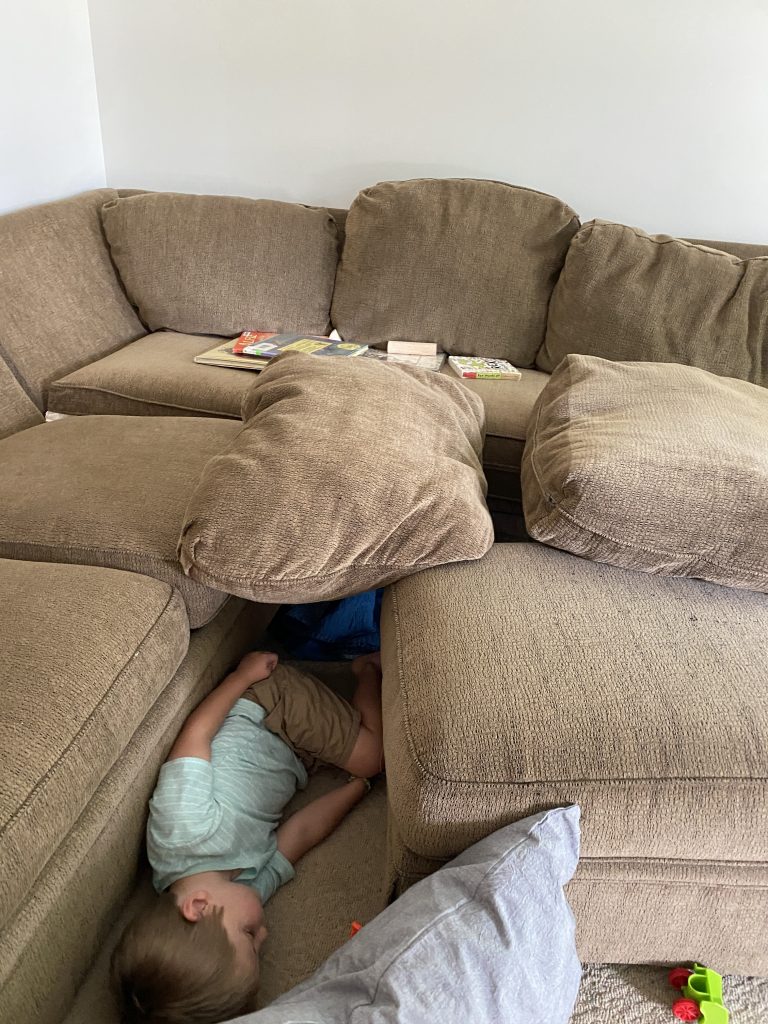
My response: “That’s fine, you don’t have to sleep.”
When Do Toddlers Stop Napping?
Toddlers will stop napping anywhere from about 2 ½ years to 4 years. Each child is different and will start to give you clues that they’re done with naps. The two main clues that your 2 year old might be ready to stop napping are:
- Hard time falling asleep at their usual bedtime. Where they may have been ready to go to bed easily before, now they are energetic and genuinely do not seem tired.
- Difficulty falling asleep at their regular nap time. Sometimes toddlers will fight nap time for a few days, but eventually, they will go back to falling asleep. But if they continue to have trouble falling asleep for a few weeks, it’s a good indicator that they may no longer need their midday nap.
Our second daughter stopped napping shortly after she turned two. We helped her transition to a quiet play-in-her-room time in the afternoon. This time, though she wasn’t sleeping, still seemed to provide a “reset” of sorts.
Nap Time/ Quiet Time FOREVER!
I highly highly recommend maintaining some sort of afternoon quiet time rhythm, even after your child stops napping! Everyone needs a break!
An afternoon quiet time will honestly make you and your child(ren) happier. We always just called it nap time and when the kid would say, “I’m not sleepy,” we’d say, “That’s fine! You don’t have to sleep. You can play quietly in your room since you’re a big girl/ boy now. What 3 special toys do you want to take with you to naps today?”
We just maintained firm, clear, and consistent boundaries with requiring them to stay in their rooms. An okay-to-wake clock that turns green works well if you have a child who is constantly asking, “Is it time to come out?”
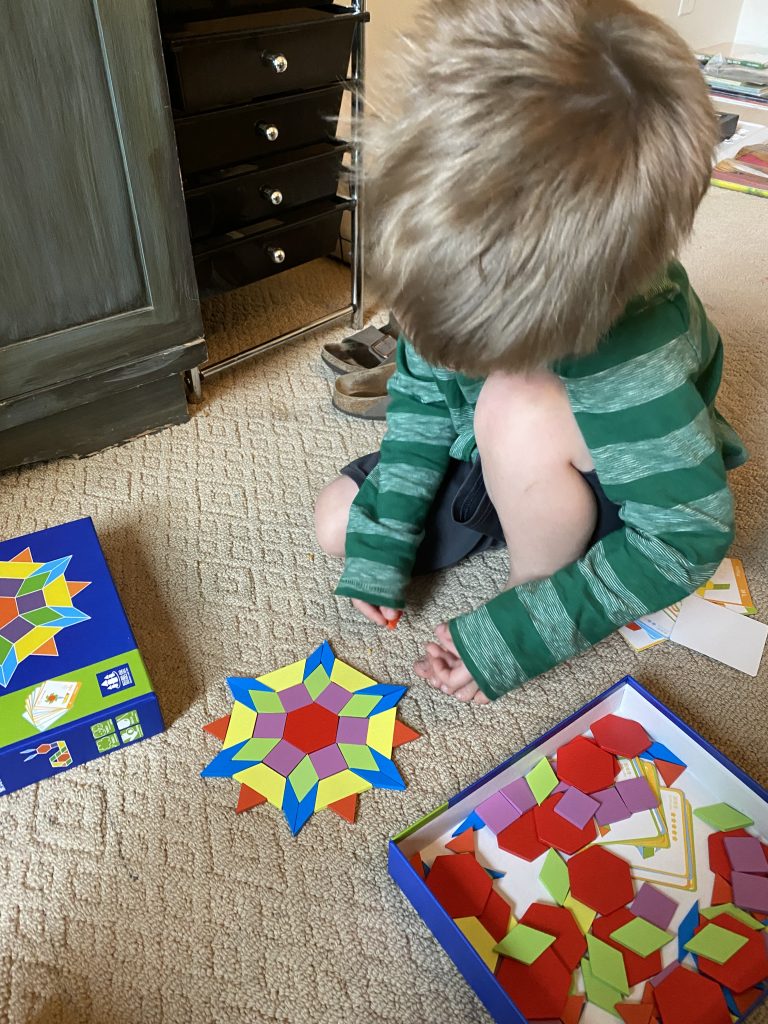
What if My Toddler Suddenly Starts Sleeping More?
Should you be concerned? The short answer is – nope! There are several reasons why your child would suddenly start sleeping more, and this increased sleeping time is usually short-lived.
Growth spurts are the most common cause of increased sleep time. Your child’s body goes through several growth spurts during their baby and toddler years. Such rapid growth puts added stress on their bodies, and they naturally sleep more to aid in development and recovery.
Increased sleeping could also be an indicator of teething (2 year molars) or coming down with a cold, or something. Always check with your pediatrician if you’re worried about a more lethargic kiddo, or need reassurance.
Okay to Wake Clock
Honestly, this okay-to-wake clock is my number 1 best tip for most toddler sleep issues. I think it works well because it’s:
- An outside authority source – if the clock isn’t green, the clock isn’t green. A toddler can’t fight with a clock.
- Concrete – toddlers think & act in a very black and white world.
- Fun & independent – the child feels like THEY are the ones who get to decide when to come out (based on the clock turning green). It allows them to transition from having to be picked up out of a crib by mom or dad to deciding when they can come out of the room. Of course, you and I know that the toddler isn’t actually deciding… the parent who sets the clock is deciding. But I won’t tell if you won’t tell 😉
The main trick to training your toddler to follow the clock is to set the wake up time for the child’s current wake up time.
Even if your child currently wakes up at 5:30 am, but your target wake up time is 7:00 am, it’s doable!! (Speaking from experience here!) You just have to give it time and be consistent.
During the day, play with the clock! Set the time to make it turn green in 1 minute and show the child how it turns green. Tell them green means wake up time. Then, play a sleeping game. Tell the child to pretend they’re asleep and watch the clock. Set the clock to turn green in 1 more minute. You go outside the door while they pretend they’re asleep. If they stop pretending, remind them to stay pretend sleeping until it turns green. When it turns green, let them come out themselves and you can be there to greet them saying, “Good morning!!” Then, switch roles and let the child be the parent outside the door.
Play this until they’re bored!
Then remind them at bedtime, you can’t come out until the clock turns green. Try to set it for a time you think they’ll be awake by so that it’s green pretty close to when they wake up. If they wake up before it turns green, put them back in bed and say, “You have to wait until it’s green.” (Quickly set it to turn green in 2 minutes.)
Do this a few nights in a row. Once they’re consistently “obeying” the clock, set it to turn green 5-10 minutes later. Keep pushing it back 5-10 or even 15 minutes each week. Eventually, the child’s body clock will likely adjust!
This magical clock has worked for all our kids.
We have this exact okay to wake clock, but here are some other ones with good reviews on Amazon!
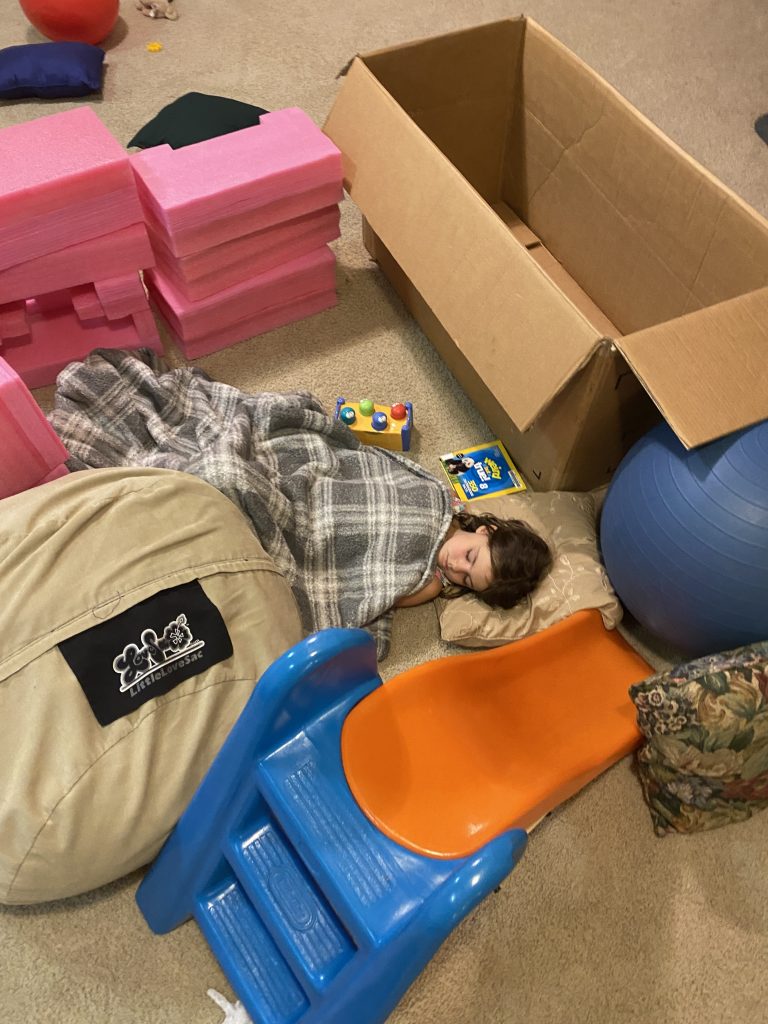
Bedtime Routine For A 2 Year Old
Everyone could benefit from a consistent bedtime routine (yes, even you, mom!), but toddlers thrive on it. Consistency helps kids feel safe because they know what’s coming up next.
Your bedtime routine will be personal to you and your child. It would be best to choose activities that calm them down and get them ready to snuggle into bed.
Keeping the same approximate daily bedtime is the first step. Even though they probably can’t tell time yet, young children still respond to continuity, and establishing a set bedtime will help their bodies adjust to sleeping at the same time each day.
Simple Bedtime Routines
We used to bathe our kids almost every night… 4 kids later, we’re lucky if they get one every week. Yikes! But, we almost always read together before bed, and I usually sing our hymn of the month after lights are out and they’re all settled. (We follow along with Happy Hymnody.)
The Biggest 2 Pieces of Advice I Can Give on Bedtime Routines Are…
- Keep it simple – the further bedtime evolves into a circus, the more your toddler is playing you. If a bedtime is important to you, set the boundaries firmly and clearly and give it a week or so. You are the adult and you can establish an expectation around bedtime.
- Let a lot go – our kids have gone through phases of only wearing particular pajamas or sleeping in clothes, or my favorite current one: a 2 year old who insists on sleeping with his plastic tool box full of plastic tools, matchbox cars, and an old broken, cordless baby monitor. Haha!! Whatever! Beyond basic safety concerns, we make no fuss about anything meaningless like that. Pick your battles and let your kids pick the rest. If the Lion King PJs get stinky, you can wash them in the morning.
Skip TV Before Bed
Lots of activity or tv right before bed may make it difficult for your 2-year-old to settle down. Try to lower the lights, shut off electronics, and switch over to quieter activities 30 minutes to an hour before bed to help with the transition.
Hmmm maybe I should give myself that advice too… it’s just so tempting to binge Netflix before bed 😉
2 Year Old Sleep Cycles (Nighttime)
Baby and toddler sleep cycles are very different from adults. As adults, we spend about 20 to 25 percent of our sleeping time in REM (Rapid Eye Movement) sleep, and each of our sleep cycles lasts about 90 to 125 minutes. Babies and toddlers’ sleep cycles are more evenly divided between REM and Non-REM sleep, and their cycles are shorter, about 50 minutes.
These differences help explain why 2-year-old’s are more likely to wake up during the night. During the REM cycle, their brains are active – they are developing and forming various cognitive and physical skills. (Adult brains are active during REM as well).
During the transition from active sleep to deep sleep, children and adults have an easier time waking up. Since toddlers have more moments of this transition, it makes sense that they would be more likely to wake during the night.
If your toddler is waking up, don’t immediately rush to their side. They may settle down and fall back asleep on their own.
If they start to cry genuinely, then, of course, go and check on them. Be reassuring but not overly active – try not to pick them up and talk too much. Just use hushed, calming tones, and get them to settle back down. Try to leave the room before they fall back asleep (so they don’t get dependent on you being there).
Toddler Sleep Problems & Sleep Regression
Besides the mechanics behind a toddler’s sleep cycle, there are many reasons why 2 year old sleep problems occur. We already talked about the need for a set bedtime and routine… without these, your child might have some issues falling asleep at night.
Here are several other common 2 year old sleep problems, along with a few ideas for how to fix them.
Potty Training
If you’re potty training, it might cause problems with your toddler staying asleep. At the beginning of potty training, we just stuck with a diaper at night. It didn’t hinder daytime potty training at all. Once the child started keeping the diaper dry, we would switch them to undies at night.
Sometimes, the potty training toddler wakes up to use the toilet. Stinks for you, but oh well! Just take them quietly and quickly and tuck them back in bed without a lot of fuss. Eventually, they’ll be able to make the trip themselves. If you try to cut back on liquid before bedtime, it might expedite the process.
Molars & Illness
Teething those 2 year molars will also cause sleep disruptions with toddlers. Ear infections or stuffy noses are common culprits. These problems can be soothed with medicine (under a doctor’s supervision) and some extra cuddles. Running a cool-mist humidifier can help with allergies and stuffiness.
Napping Too Late
Another reason your 2-year-old may be having trouble sleeping is that the amount of sleep needs to be adjusted. Try to watch the child’s cues and see if you need to adjust bedtime or nap time intervals like we talked about earlier.
Toddler Sleep Regression
If your normally sleepy 2 year old won’t sleep, they could be experiencing sleep regression. Sleep regression in toddlers definitely happens! You see it in a child who is having trouble falling asleep, is fighting nap time, and/or waking through the night.
This regression usually occurs when a child is between 2 and 2 ½ years of age. It happens with children who previously had no problems going to bed and taking naps. All of a sudden, it seems they are fighting sleep every chance they get! While it can be frustrating, remember it is also normal and (thankfully) temporary.
The best way to deal with all of these issues is to stay the course! Keep your routines, have patience, and give yourself a lot of grace. If you continue to provide a consistent ritual and bedtime, eventually your child will go back to being a great sleeper.
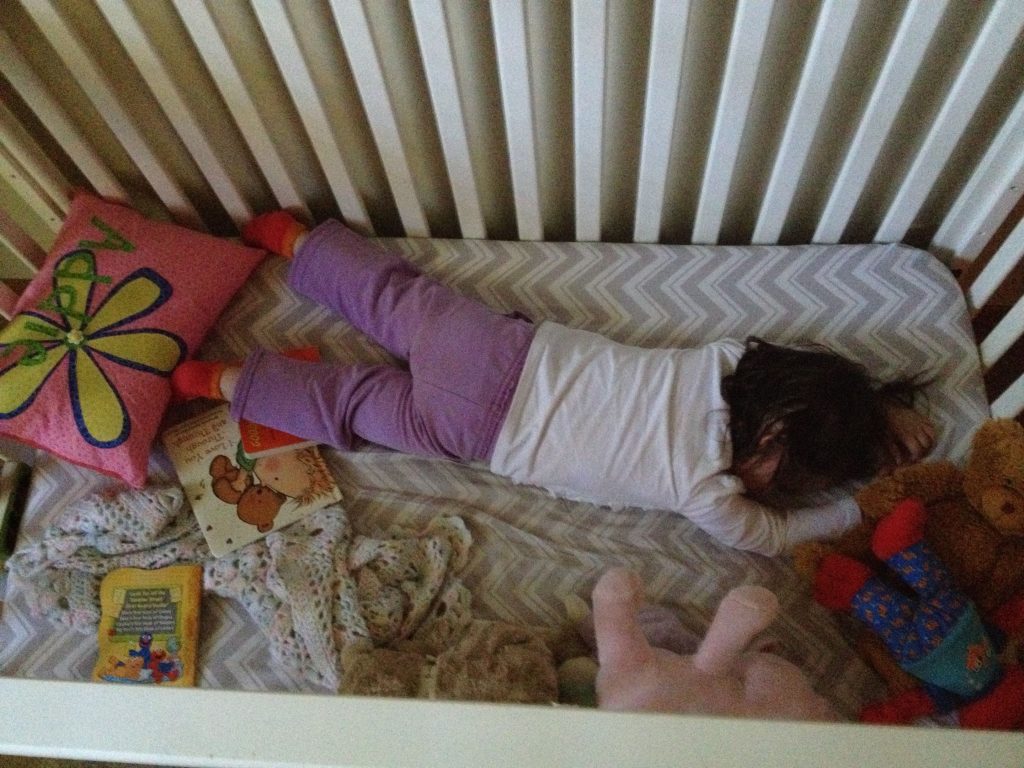
Sample Sleep Schedule for 2 Year Olds & Ideas for Daily Routines
I polled a facebook community of moms and got a few ideas for various versions of daily toddler schedules, including toddler sleep schedules! Ultimately, you should create a routine based on your family’s needs. But here are some schedule ideas in case it helps you.
The Early to Bed, Early to Rise Schedule
6:00 am – child wakes up and plays in their room until 6:30 (use an Okay-to-wake clock to train this)
6:30 am – child comes to kitchen for breakfast
7:30 am – room tidy & get ready for the day
8:00 am – free play, outside time
9:00 am – outing
10:30-11 am – lunch
11:30 -12:00 – begin nap time with a wind-down story reading routine
12:00-2:00 pm – nap
2:00 – 4:00 pm – snack, free play, outside time
4:00-5:00 pm – dinner prep, tidy time, media
5:00 pm – dinner
5:45 pm – get ready for bed
6:30 pm – in bed (option to play quietly or read until 7:00 pm)
The Later Morning, Later Bedtime Schedule
This schedule would look very similar to the above rhythm but you might shift everything back an hour or two 🙂
The Flexible Daily Schedule
This is our family’s approach. Our kids (currently 2-7 years old) are mostly awake between 7:00-7:30am, and mostly in bed by 7:30 pm (reading until asleep by 8:00-8:30pm).
The rest of our day has a relatively basic flow, but it’s pretty flexible based on the seasons & what we have going on any given day.
- The mornings mostly being devoted to homeschooling & activities.
- The early afternoons are mostly for quiet time/ independent play/ quiet reading.
- The late afternoons are mostly for tidying up, playing outside.
- The evenings are mostly for dinner, family time, eating with extended friends & family, and reading aloud.
We eat lunch between 11:00-12:00 pm most days, depending on our morning outings & snacks. The kids rest for about 2 hours sometime between 12:00-4:00pm, depending on our day’s outings and evening plans. Then, we eat between 5:00-6:00 pm. We usually start bedtime routines around 6:30pm in the winter (with a lot longer reading time) and 7:30 or 8:00 pm in the summer (when the kids are often out playing after dinner until dusk).
Our day was quite a bit less flexible when we had 4 kids 5 and under, and having that set nap time from 12:30-3:00 pm was more crucial for their happiness and my sanity. 🙂
The Can’t-Take-A-Long-Nap-But-Might-Turn-Into-A-Monster Schedule
7:00 am – child wakes up and plays in their room until 7:30 (use an Okay-to-wake clock to train this)
7:30 am – child comes to kitchen for breakfast
8:00 am – room tidy & get ready for the day
8:30 am – free play, outside time
9:00 am – outing
11 am – lunch
12:00 – read for a while to wind down; choose special playtime toys that will hopefully keep child awake for a while
*Once you figure out your child’s maximum sleeping time that doesn’t interfere with bedtime, make sure to wake them up at a good time! You can train them to have some fun quiet play time before/ after sleeping too.
2:00 – 4:00 pm – snack, free play, outside time
4:00-5:00 pm – dinner prep, tidy time, media
5:00 pm – dinner
6:00 pm – play time/ family time/ walk/ etc.
7:00 pm – bedtime routine
7:30/ 8:00 pm ish – bedtime!
Goodnight, Sleep Tight!
Sleep is so important to a toddler’s well-being, but 2 year olds can develop particular challenges when it comes to maintaining naps and bedtime schedules. Using this information and tips, I hope you can create an enjoyable bedtime routine that you and your child will look forward to every day.
And remember, if your toddler is a monster, just put him to bed 😉 Tomorrow is a new day!
RELATED POSTS:
Archive of Posts about Toddlers!
22 Tips for Surviving a Road Trip with Toddlers
How to Make a Bedtime Routine that Works for YOUR family
